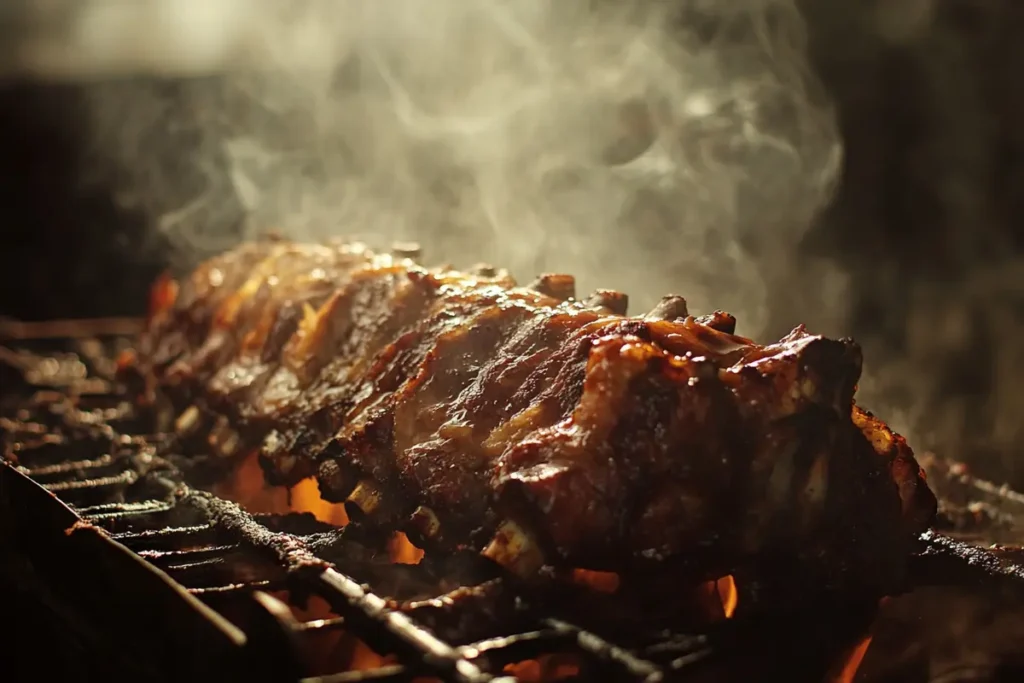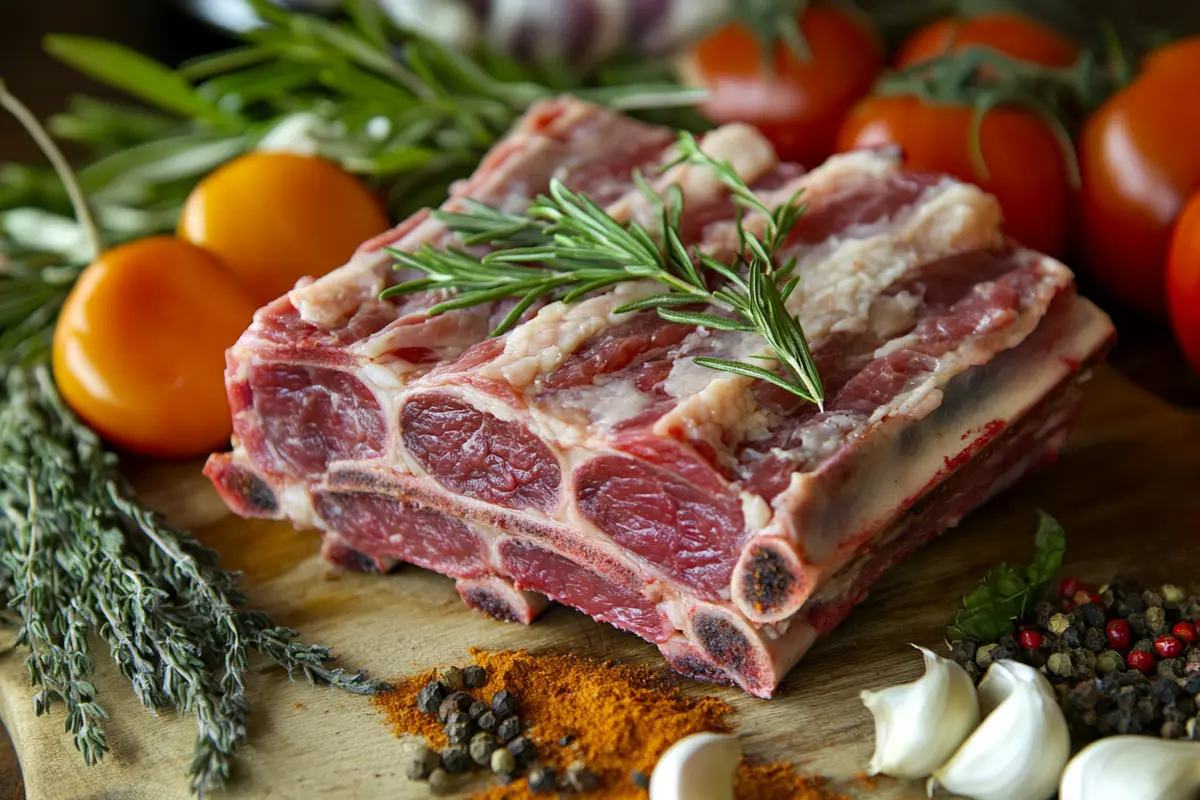Beef back ribs are a treasure trove of bold, beefy flavor that, when cooked properly, transforms into a mouthwatering dish you’ll want to savor every time. Whether you’re preparing them in the oven, on the grill, or in a smoker, beef back ribs recipes are versatile and deeply satisfying. This guide will walk you through everything from selecting the perfect cut to serving these tender ribs with side dishes that complete the feast. You’ll learn handy tips, avoid common pitfalls, and discover flavor-packed variations that elevate your meal to restaurant quality. Let’s dive right in!
Table of Contents
What Are Beef Back Ribs?
Beef back ribs come from the top part of the ribcage near the backbone, just below the ribeye section. They are prized for their deep, beefy flavor and are often sold with more bone than meat, as much of the meat is trimmed off to create ribeye steaks. Their origins trace back to traditional cattle farming practices where every part of the cow was utilized, ensuring no cut went to waste.
When comparing beef back ribs to short ribs, the differences are stark. Short ribs are meatier and cut from the lower section of the ribs, closer to the breastbone. In contrast, back ribs are leaner but make up for it with their finger-licking flavor and the tender meat that clings to the bones. Both cuts have their merits, but back ribs are unparalleled for those seeking an authentic, smoky BBQ experience.
Why Choose Beef Ribs?
The flavor profile of beef back ribs is bold, robust, and unmistakably beefy. The texture is tender when cooked low and slow, with just the right amount of chew to keep things interesting. They’re versatile, adapting beautifully to various marinades, rubs, and cooking methods.
On the nutritional side, beef back ribs are an excellent source of protein, zinc, and iron. They’re hearty and satisfying, making them an ideal choice for anyone seeking a balanced meal with a punch of flavor. Pair them with fresh vegetables or lighter sides to round out the dish nutritionally.
Choosing the Best Beef Back Ribs
When buying beef back ribs, freshness is key. Look for ribs with a vibrant red color, a sign of freshness and quality. Avoid packages with excessive liquid, as this might mean the meat has been frozen and thawed.
Deciding between fresh and frozen ribs often depends on your timeline. Fresh ribs deliver superior flavor and texture, while frozen ribs can be a convenient backup. Regardless, ensure the ribs are well-marbled but not overly fatty, and request help from a trusted butcher for the best cuts.
Tools You Need
Having the right tools ensures the cooking process is smooth and successful. Here’s a list of must-haves:
- Grill or Smoker: For that signature smoky flavor.
- Oven: A reliable option for baking the ribs evenly.
- Tongs: To handle the ribs without piercing the meat.
- Meat Thermometer: To check internal temperature and avoid overcooking.
- Baking Tray and Aluminum Foil: For oven-cooked ribs to retain moisture.
- Basting Brush: To apply marinades or sauces for a glossy finish.
Ingredients for Beef Ribs Recipe
To create the best beef back ribs recipe, gather these simple ingredients:
- Beef Back Ribs: About 2-3 pounds, cleaned and trimmed.
- Dry Rub: A mix of brown sugar, paprika, garlic powder, onion powder, salt, and black pepper.
- BBQ Sauce: Store-bought or homemade for basting and dipping.
- Olive Oil: To help the dry rub adhere to the ribs.
- Apple Cider Vinegar: To tenderize and enhance flavor.
If you’re missing any ingredients, don’t fret! Substitutes like honey instead of brown sugar, or white vinegar in place of apple cider vinegar, work just as well. Tailor the rub and sauce to suit your preferences—whether spicy, tangy, or sweet.
How to Prepare Ribs for Cooking
Preparation is crucial for ensuring your beef back ribs turn out tender and flavorful. Start by cleaning and trimming the ribs. Rinse them under cold water to remove any residue, then pat them dry with paper towels. Look for excess fat or cartilage and trim it away with a sharp knife. While fat adds flavor, too much can prevent the seasoning from sticking or create a greasy texture.
Next, focus on removing the membrane, which is a tough, silvery layer on the bone side of the ribs. Slide a knife under one corner of the membrane, lift it slightly, then use a paper towel to grip and pull it off. This step ensures the ribs absorb marinades and seasonings better and become more tender during cooking.
Marinating and Seasoning the Ribs
To infuse your ribs with incredible flavor, marinating or applying a dry rub is essential.
- Best Dry Rub Recipes for Beef Back Ribs
A simple, go-to dry rub includes:
- 2 tablespoons brown sugar
- 1 tablespoon smoked paprika
- 1 teaspoon garlic powder
- 1 teaspoon onion powder
- 1 teaspoon salt
- 1 teaspoon black pepper
Mix the ingredients, coat the ribs generously, and let them sit for at least 30 minutes or overnight for a deeper flavor.
- Recommended Marinades for Extra Flavor
For those who love a tangy kick, a marinade made from olive oil, apple cider vinegar, soy sauce, and minced garlic works wonders. Combine the ingredients, brush it over the ribs, and refrigerate them for at least 2 hours. This tenderizes the meat and enhances its natural beefy flavor.
How to Cook Beef Ribs
Beef back ribs are versatile and can be cooked using various methods. Whether baked, grilled, or smoked, each technique brings out unique flavors and textures.
Oven-Baked Beef Back Ribs Recipe
If you want tender, fall-off-the-bone ribs, baking is the way to go.
- Step-by-Step Process:
- Preheat your oven to 275°F.
- Line a baking tray with foil and place the seasoned ribs on it.
- Cover the tray tightly with foil to lock in moisture.
- Bake for 2.5–3 hours until the ribs are tender.
- Suggested Temperature and Time:
Bake at a low temperature (275°F) to ensure the ribs cook slowly, breaking down the connective tissue and making the meat tender.
Grilled Beef Back Ribs Recipe
For smoky, charred flavors, grilling is a fantastic choice.
- How to Achieve Smoky and Charred Flavors:
- Preheat your grill to medium heat (around 350°F).
- Sear the ribs over direct heat for 5 minutes per side to create a crust.
- Move the ribs to indirect heat and cook for an additional 1.5–2 hours.
- Direct vs. Indirect Grilling Methods:
- Direct Heat: Ideal for creating a crispy exterior but not for cooking the ribs thoroughly.
- Indirect Heat: Slower cooking ensures the ribs are tender inside and flavorful throughout.
Smoked Beef Back Ribs Recipe
Smoking ribs imparts a rich, deep flavor unmatched by other methods.
- Tips for Smoking Ribs for a Rich Flavor:
- Preheat your smoker to 225°F.
- Use a mix of fruitwood chips (apple, cherry) or hickory for robust flavor.
- Smoke the ribs for 5–6 hours, spritzing them occasionally with apple juice for added moisture.
- Wood Chips to Use for Smoking Beef Ribs:
Applewood offers a mild sweetness, while hickory provides a stronger, smoky flavor. Combine both for a balanced profile.

How to Know When Beef Back Ribs Are Done
Perfectly cooked ribs are tender but not mushy, and they should pull away from the bone with a gentle tug.
Internal Temperature Guidelines
The internal temperature of fully cooked beef back ribs should reach 190°F–203°F. Use a meat thermometer to check the thickest part of the meat without touching the bone.
Signs of Perfectly Cooked Ribs
- The meat is tender and slightly shrinks back from the bones.
- A fork slides into the meat with minimal resistance.
- The ribs have a beautiful caramelized crust if baked or grilled.
How to Serve Beef Ribs
Once your beef back ribs are cooked to perfection, it’s time to plate them beautifully and enjoy the fruits of your labor. Start by letting the ribs rest for about 10 minutes; this helps lock in the juices, ensuring every bite is succulent.
When slicing, use a sharp knife and cut between the bones, keeping each rib intact for easy serving. Arrange the ribs neatly on a large platter, garnished with fresh herbs or a sprinkle of coarse salt for added visual appeal.
Best Side Dishes for Beef Back Ribs
The rich flavor of beef back ribs pairs wonderfully with a variety of side dishes. Some popular options include:
- Coleslaw: The creamy tanginess cuts through the ribs’ smoky richness.
- Baked Beans: A hearty, slightly sweet side that complements the ribs.
- Mashed Potatoes: Smooth, buttery potatoes balance the bold flavors of the meat.
- Cornbread: A touch of sweetness and crumbly texture adds depth to the meal.
For a fresher option, consider a crisp green salad or roasted seasonal vegetables. These lighter sides add balance and variety to your plate.
Sauces That Pair Well with Beef Back Ribs
The right sauce can elevate your beef back ribs recipe to the next level. Here are a few favorites:
- BBQ Sauce: Sweet and smoky barbecue sauce is a classic choice.
- Spicy Dips: For those who love heat, try a zesty jalapeño or chipotle dip.
- Homemade Glazes: A simple honey and garlic glaze adds a glossy, sweet finish.
Serve sauces on the side so everyone can customize their ribs to their taste.
Pro Tips for Perfect Beef Back Ribs
Mastering the art of beef back ribs is easier with a few expert tips:
- How to Make Ribs Tender and Juicy: Cook them low and slow, whether in the oven, on the grill, or in a smoker. This ensures the connective tissue breaks down, resulting in tender meat.
- Common Mistakes to Avoid:
- Don’t skip removing the membrane—it can make the ribs tough.
- Avoid overcooking, as it can dry out the meat.
- Never rush the process; great ribs take time!
- Resting the Ribs for Maximum Flavor: Allow the ribs to rest for at least 10 minutes before cutting. This step keeps the juices evenly distributed throughout the meat.
Adjusting Cooking Times for Different Methods
Every cooking method requires slightly different timing to achieve perfect results:
- Oven: Bake at 275°F for 2.5–3 hours for tender ribs.
- Grill: Use indirect heat for 1.5–2 hours after an initial sear over direct heat.
- Smoker: Keep the temperature steady at 225°F and cook for 5–6 hours, checking for doneness around the 5-hour mark.
Adjust times based on the size of the ribs and your preferred level of tenderness. Patience truly pays off when crafting the perfect beef back ribs recipe.
How to Store Leftover Beef Ribs
Leftover beef back ribs can be just as delicious the next day if stored properly. Begin by letting the ribs cool completely to room temperature. Once cooled, wrap them tightly in aluminum foil or place them in an airtight container to preserve their moisture and flavor.
For short-term storage, keep the ribs in the refrigerator, where they’ll stay fresh for up to 3–4 days. If you want to save them for a longer period, freeze the ribs. When freezing, wrap them in foil first and then place them in a freezer-safe bag to prevent freezer burn. They’ll maintain their quality for up to three months in the freezer.
Best Ways to Reheat Beef Back Ribs
- Oven Reheating for Juicy Ribs
- Preheat your oven to 250°F.
- Place the ribs on a baking sheet and cover them with foil to retain moisture.
- Heat for about 20–30 minutes, or until the internal temperature reaches 165°F.
- Using a Grill or Air Fryer for Quick Reheating
- Grill: Heat the grill to medium heat, place the ribs on the grates, and warm for 10–15 minutes, turning occasionally.
- Air Fryer: Preheat the air fryer to 350°F, place the ribs in a single layer, and heat for 5–7 minutes.
Both methods will restore the ribs’ crispy edges while keeping the meat tender and flavorful.
Flavorful Variations of Beef Back Ribs
Spicy Cajun-Style Beef Ribs
Add a bold kick to your beef back ribs recipe by using a Cajun-inspired dry rub made from cayenne pepper, paprika, garlic powder, and oregano. Smoke or grill the ribs, and finish with a squeeze of fresh lemon for a zesty punch.
Sweet and Tangy BBQ Ribs
For a classic backyard BBQ flavor, baste the ribs with a sweet and tangy sauce made from ketchup, brown sugar, apple cider vinegar, and a hint of mustard. Bake or grill to caramelize the sauce, creating a sticky, finger-licking glaze.
Asian-Inspired Soy-Glazed Ribs
Combine soy sauce, honey, ginger, garlic, and a splash of sesame oil for a savory, sweet glaze. Marinate the ribs overnight for maximum flavor, then bake or grill until the glaze is beautifully caramelized.
Keto and Low-Carb Beef Back Ribs
To make keto-friendly beef back ribs, skip the sugary sauces and opt for a dry rub featuring smoked paprika, garlic, onion powder, and cayenne pepper. Serve with low-carb sides like cauliflower mash or roasted asparagus to keep the meal healthy and satisfying.
Vegan Alternatives to Beef Back Ribs
For plant-based eaters, consider making “ribs” using jackfruit, seitan, or tofu. Season these substitutes with the same dry rubs and sauces used for beef ribs. Bake or grill to mimic the smoky, tender texture of traditional ribs. This variation offers the satisfaction of ribs while catering to a vegan lifestyle.
Frequently Asked Questions
How long should I cook beef back ribs in the oven?
Cooking beef back ribs in the oven typically takes 2.5–3 hours at 275°F. Slow-cooking at a low temperature ensures tender, juicy ribs with a deliciously caramelized crust.
What temperature should beef back ribs be cooked to?
The internal temperature for perfectly cooked beef back ribs is 190°F–203°F. Use a meat thermometer to check the thickest part of the ribs without touching the bone.
Can I make beef back ribs without a grill?
Absolutely! Oven-baking or using a smoker are excellent alternatives. Both methods allow for tender and flavorful ribs without needing a grill.
What is the difference between beef back ribs and spare ribs?
Beef back ribs are cut from the upper ribcage, near the backbone, and have less meat than spare ribs. Spare ribs are larger, meatier, and cut from the lower part of the ribs, closer to the belly.
How do I keep beef back ribs moist?
Wrap the ribs in foil during cooking to retain moisture, and baste them with sauces or marinades to prevent drying out. Resting the ribs after cooking also helps retain their juices.
Are beef back ribs good for smoking?
Yes, beef back ribs are fantastic for smoking! The long cooking process allows the smoky flavors to penetrate the meat, creating a rich, mouthwatering taste.
Enjoy the Best Beef Back Ribs Recipe
Cooking beef back ribs is a rewarding experience that fills your kitchen with irresistible aromas and delivers a meal that’s worth savoring. By following this step-by-step guide, you can create ribs that are tender, flavorful, and perfectly seasoned, no matter your chosen cooking method.
From selecting the freshest cuts to mastering the art of baking, grilling, or smoking, this beef back ribs recipe guarantees a satisfying culinary journey. Pair your ribs with delicious sides, experiment with variations, and don’t forget to try the tips for optimal flavor and texture.
Now it’s your turn! Gather your ingredients, follow the steps, and enjoy a homemade feast that rivals restaurant-quality ribs. Share your experience or ask questions in the comments—we’d love to hear about your take on this ultimate beef back ribs recipe!

